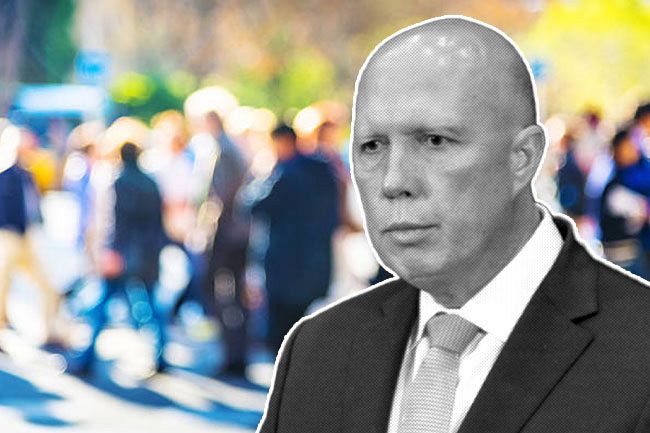Several factors have led to the Coalition's proposed net migration target of 160,000 being impossible, writes Dr Abul Rizvi.
WITH THE ELECTION DEBATE on net migration hotting up, it's worth re-visiting whether we are on track to hit Treasury’s net migration forecast for 2024-25 of 335,000 (falling from 445,000 in 2023-24). That will give us a better understanding of whether Treasury’s forecast of net migration in 2025-26 of 260,000 or Opposition Leader Peter Dutton’s proposed target of 160,000 could be achieved.
The best early indicator of the level of net migration is the monthly data on net permanent and long-term (NPLT) movements published by the Australian Bureau of Statistics. While COVID disturbed the relationship between NPLT and net migration, that appears to now be returning to normal, with NPLT again slightly higher than net migration on an annual basis (see Chart 1).

We now have seven months of NPLT data for 2024-25 which we can compare to data for the same period in 2023-24 and with a pro rata target based on Treasury’s revised net migration forecast for 2024-25 of 335,000 (up from the 2024-25 forecast of 260,000 in the 2024 Budget). Treasury has developed a habit of overestimating the fall in net migration.
In most of the seven months to February 2025, NPLT movements have been below that for the same months in 2023-24. That confirms net migration is falling and will be substantially below the 2023-24 level of 445,000. But is it falling fast enough to get to the Treasury forecast of 335,000? The fact that NPLT was substantially higher in February 2025 than in February 2024 would be worrying Treasury (see Chart 2).

NPLT for the whole seven months to February 2025 was 328,660 compared to 363,550 in the seven months to February 2024. To hit its net migration forecast for 2024-25 of 335,000, Treasury would have liked NPLT for the seven months to February 2025 to be between 275,000 and 300,000. Other than in August 2024 and December 2024, NPLT has been above the pro rata level needed to hit the Treasury forecast.
Using NPLT data to February 2025 and if NPLT for the remaining four months of the financial year was 25 per cent below the same period in 2023-24, gives an NPLT outcome for 2024-25 of 408,000. On that basis, net migration for 2024-25 is likely to be over 350,000, assuming a return to the normal NPLT and net migration relationship.
Net migration in 2025-26
And what of Treasury’s net migration forecast in 2025-26 of 260,000? Or the Coalition’s target of 160,000 in 2025-26?
Labor has not at this stage announced any significant further policy tightening for 2025-26. It has not even released any details of its 2025-26 migration program, which it will be under pressure to increase.
Treasury’s forecast of a further fall in net migration to around 260,000 in 2025-26 relies heavily on a rapid and very large increase in departures of students and temporary entrants. While departures will rise simply because of the unprecedented size of the student and temporary entry cohort currently in Australia, there is strong evidence that students and temporary entrants are to extend their stay, especially as the labour market remains strong. That was inevitable.
In addition, a sharp economic slowdown in the U.S., as currently being forecast, would put upward pressure on net migration as more Australian expats return to Australia and fewer leave. We may even see a rise in U.S. citizens seeking to come to Australia long-term, noting that the Work and Holiday visa for U.S. citizens is uncapped.
Moreover, the Labor Government does not have an effective tool for capping students after its capping legislation failed to pass the Senate in late 2024.
In these circumstances, net migration falling to 260,000 in 2025-26 looks highly unlikely.
The announced Coalition policies to reduce net migration in 2025-26 to 160,000 are even more unlikely. There is significant doubt that the Coalition will be able to cut the permanent migration program by 45,000.
Despite earlier statements to the contrary, Dutton has now confirmed he will not provide details of his 45,000 cut ahead of the Election, but he has been trapped into saying he will not cut parent visas. That means to maintain the skill/family program balance he says he wants, he must cut partner and/or dependent child visas, which legally he cannot do.
After opposing Labor’s student capping legislation, Dutton has proposed that he will cap students at 30,000 less than Labor’s proposed cap. But securing and implementing new student capping legislation (presumably somehow different to Labor’s student capping legislation) will likely take up most of 2025-26. The Senate will not easily wave this through after all the criticisms the Coalition made of Labor’s student capping legislation.
In addition, Dutton must find a way to:
- accommodate his commitment to re-introduce the Significant Investor visa;
- substantially increase migration of construction tradies;
- implement Nationals Leader David Littleproud’s commitment to reintroduce his Agriculture visa; and
- meet Littleproud’s demand that visas that benefit regional Australia remain untouched.
The fact is, without a very major deterioration in the labour market, there is no chance the Coalition could reduce net migration to 160,000 in 2025-26. It won’t even get close.
Dr Abul Rizvi is an Independent Australia columnist and a former Deputy Secretary of the Department of Immigration. You can follow Abul on Twitter @RizviAbul.
 This work is licensed under a Creative Commons Attribution-NonCommercial-NoDerivs 3.0 Australia License
This work is licensed under a Creative Commons Attribution-NonCommercial-NoDerivs 3.0 Australia License
Support independent journalism Subscribe to IA.

Related Articles
- Net migration to be key election issue
- Working holidaymakers contributing strongly to net migration
- Dutton's permanent migration target another broken promise
- Treasury forecasting huge departures increase to drive down net migration
- Australian Treasury increases net migration forecast












